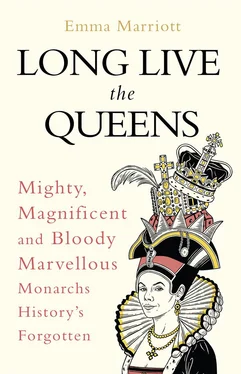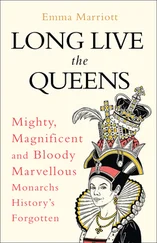In 1856, Nzinga negotiated peace with the Portuguese, exchanging 130 slaves for the return of her still-captive sister, Mukumbu. In return, the Portuguese established a Christian mission in Matamba and the Jaga were forced to abandon their practice of infanticide. Nzinga herself reconverted to Christianity and focused on developing Matamba as a trading power, making the most of its position as the gateway to the interior of Central Africa. Despite many attempts by the Portuguese and their allies to dethrone or kill Queen Nzinga, she died peacefully at the age of eighty in 1663, leaving Matamba a strong commercial state.
Queen Nzinga proved to be a constant thorn in the side of the Portuguese and one of Africa’s most successful, feared and respected leaders. The respect she earned lasted through the centuries, so much so that one America writer, in promoting the emancipation of the slaves, wrote in 1833: ‘History furnishes very few instances of bravery, intelligence and perseverance equal to the famous Zhinga, the queen of Angola.’


Born: 1837
Died: 1898
Empress Elisabeth of Austria, Queen of Hungary, has long had admirers around the world. Nicknamed ‘Sisi’ as a child, she was reluctantly thrust into the limelight when she married Emperor Franz Joseph I, after which her fame only grew. She is still a much-loved figure in Austria and Germany and around the world, so much so that there is even a limited-edition ‘Empress Sissy’ Barbie doll, complete with dazzling diamonds in her hair.
And yet the Empress’s fame does not extend to many English-speaking parts of the world, where she is in fact little known. In Germany and Austria, much of her fame derives from a series of 1950s films, the Sissi trilogy, which remain amongst the most popular movies in both countries and obligatory viewing at Christmas (rather like another Austrian-based film, The Sound of Music ). In the Sissi films, for which they for some reason added another ‘s’ to her nickname, the young Elisabeth is portrayed by the glamorous Romy Schneider in a highly romanticised and sanitised version of her life. It was a role that Schneider came to loathe, saying later, ‘Sissi sticks to me like porridge.’
The events of Elisabeth’s life do seem to have all the trappings of a fairy-tale story, but there was a darker, more complex side to the Bavarian-born queen whose life would end (spoiler alert) under violent circumstances, all strangely reminiscent of another royal icon of the twentieth century, Princess Diana. When Elisabeth became Empress in 1854, the creaking Austrian empire encompassed some fifty states and was facing mounting discontent as nationalist fervour swept Europe after the uprisings of 1848. Prussia and Germany were also gaining power and the Hapsburg monarchy, which Franz Joseph ruled, was struggling to keep control of Austria and Hungary.
Into this turbulent world entered the sixteen-year-old Elisabeth. She had grown up in Bavaria, now a state in Germany. Despite being of noble stock, the fourth child of Duke Maximilian Joseph of Bavaria and Princess Ludovika had a carefree outdoor existence riding horses and playing in Bavarian forests. Nonetheless, Elisabeth’s mother soon turned her attention to marriage for her daughters and set her sights on her nephew, Franz Joseph, who had become Emperor of Austria in 1848 at the age of eighteen. She initially intended Elisabeth’s older sister Helene to marry the Emperor, but when both the girls met him, it was clear he favoured the more shy and introverted Elisabeth. Still a young fifteen, Elisabeth was similarly dazzled by the Emperor; however, she was anxious about his standing, remarking, ‘I love the Emperor. If only he were not the Emperor.’ It was a prescient statement, one that would foretell the sorrows of her later life.
On 24 April 1854, the two were married and Elisabeth became Empress of Austria. Almost instantly, she found the strict conventions of the Imperial Court in Vienna stifling and in stark contrast to the freedoms of her childhood. There was also little privacy and when the couple consummated their marriage, everyone at court knew about it the next morning. Elisabeth also had to contend with the Emperor’s domineering mother, Archduchess Sophie, who scrutinised everything about the Empress, whilst Franz Joseph toiled relentlessly at his work. The Emperor was thoroughly decent and loved his wife, but he was also conventional and lacking in imagination, whereas Elisabeth lived in a very different world. Whilst shy, she was more spontaneous, highly strung and sensitive, expressed herself in poetry and was drawn to nature. As a result, she was largely miserable in Vienna, and increasingly began to avoid her duties at court.
Elisabeth was, nonetheless, quick to fall pregnant and gave birth to her first daughter in 1855, ten months after the marriage. Archduchess Sophie took complete charge of the baby, labelling Elisabeth a ‘silly young mother’, and insisted the child be given her name. The following year, another daughter, Gisela, was born, although this time Elisabeth stood up to her mother-in-law. However, tragedy would strike soon after when both children became ill during a trip to Hungary, resulting in the death of two-year-old Sophie. Elisabeth relinquished control of Gisela and sank into a long depression, which didn’t lift until she gave birth to a son, Rudolf, the following year in 1858.
From the outset, Elisabeth detested crowds and making public appearances, although her beauty, which she went to great lengths to maintain, added to her renown and popularity. She was famed for her long chestnut hair, which she was said to spend three hours a day attending to. She maintained a punishing exercise regime, involving hours of physical activity every day, from hikes and riding to gym work, and severely limited her food intake as she was obsessed with her weight. Showing clear signs of an eating disorder, she also suffered from sleeplessness, fits of coughing and various other physical complaints, which prompted doctors to advise that she travel to foreign climes for her health. She seized the opportunity to get away from the ‘prison fortress’ of court, and travelled to, amongst other places, Madeira, Corfu, and her family in Bavaria, and seemed often to recover when she was away from Vienna.
Early on in her reign, Sisi had developed a keen interest in Hungary, mastering its language and sympathising with rebels there, which prompted her to speak at court on behalf of their cause. She also formed a close alliance and friendship (and some rumoured romance) with the Hungarian statesman Count Gyula Andrássy. In 1866, after Austria had been defeated by the Prussians, Elisabeth and her children sought refuge in Budapest. Soon after, and largely facilitated by Sisi’s lobbying at court, Andrássy negotiated terms with Franz Joseph that created the Austro-Hungarian Compromise of 1867, creating a dual monarchy in which Hungary and Austria would be equal partners. In June 1867, Franz and Elisabeth were crowned monarchs of Hungary and given the castle of Godollo outside Budapest. Andrássy became Prime Minister and Elisabeth remained at Godollo, giving birth to her final child, Maria Valerie, there in 1868.
In her new role as Queen, Elisabeth was able to spend even more time away from Vienna in Hungary, where she continued to raise Maria Valerie. She and the Emperor were increasingly living separate lives and by 1885 it was an open secret that Franz Joseph was conducting an affair with an actress from a Vienna theatre. Elisabeth herself was also aware of and accepted the situation.
Читать дальше














